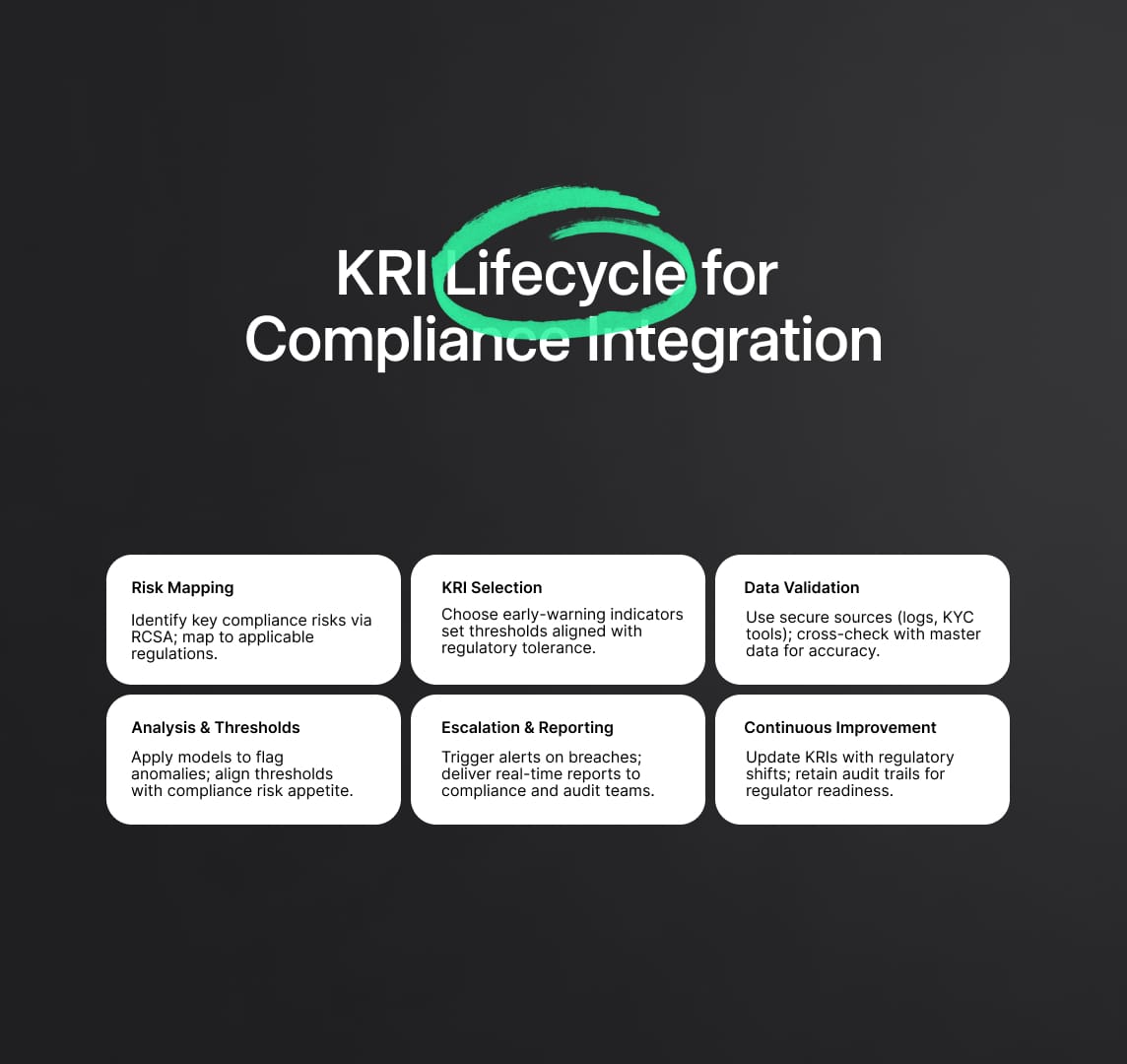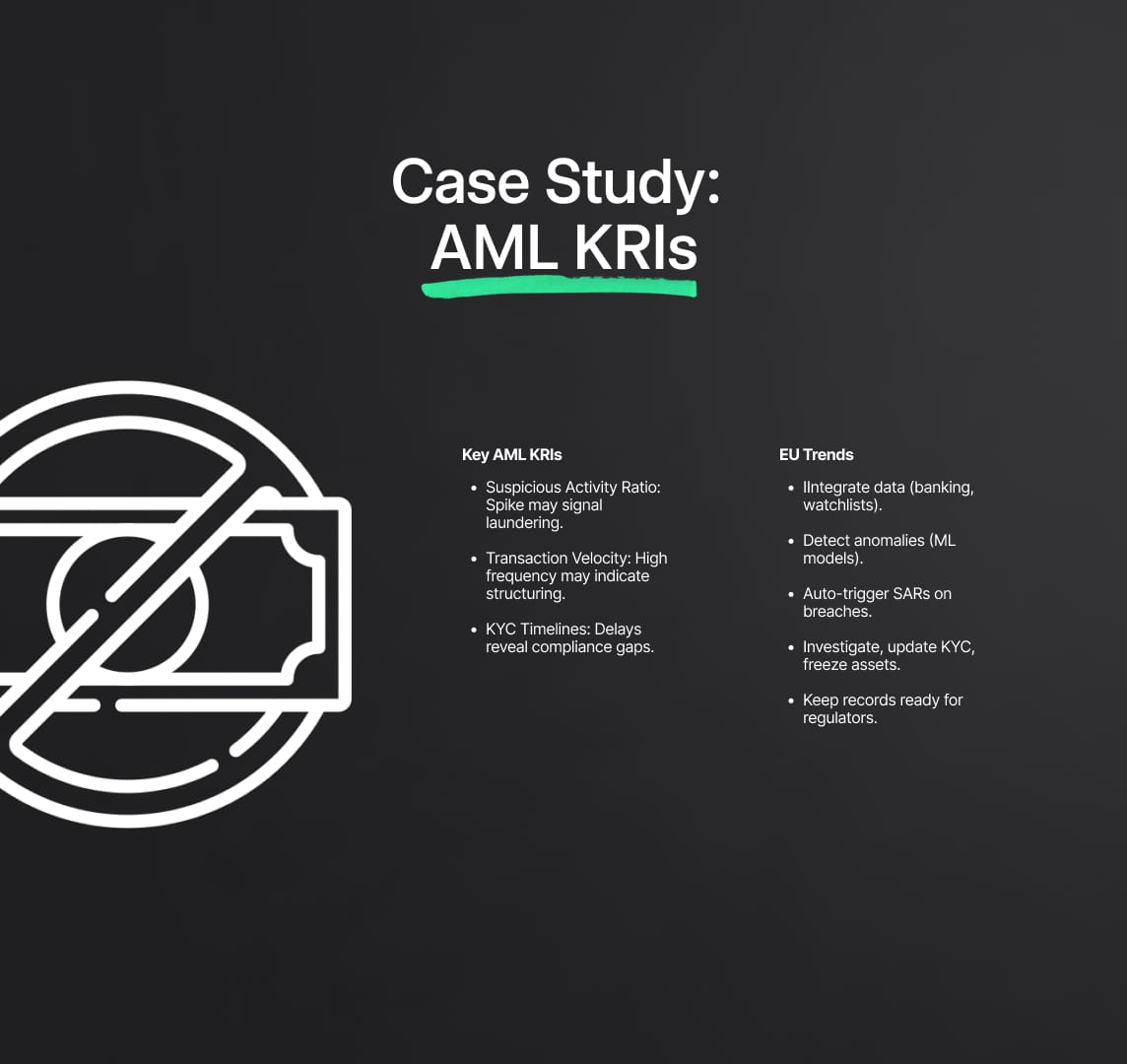Key Risk Indicators (KRIs) in a Compliance-Driven World
Risk Indicators (KRIs) have become indispensable tools, distilling data, guiding strategies, and ensuring proactive risk management.

KRIs Within a Compliance Context
Key Risk Indicators (KRIs) are measurable metrics designed to detect and forecast the likelihood of negative events that could jeopardize organizational objectives. While KRIs traditionally focus on operational and financial risks, a growing emphasis on compliance means these metrics must also map to regulatory and legal exposures.
1.1 The Evolving Compliance Landscape
- Stricter Oversight: Global watchdogs like the Financial Action Task Force (FATF), European Banking Authority (EBA), and the U.S. Office of the Comptroller of the Currency (OCC) are issuing more granular guidelines on compliance and risk governance.
- Complex Regulatory Ecosystem: From GDPR in data privacy to MiFID II in financial markets, enterprises now contend with a labyrinth of rules, each demanding a risk-based approach.
1.2 Why KRIs Are Critical for Compliance
- Early Warning: Compliance failures often manifest in subtle, early signals (e.g., transaction anomalies, conflict-of-interest red flags). KRIs identify deviations before they escalate.
- Regulatory Expectations: Many frameworks (e.g., Basel III, ISO 31000, COSO ERM) specify that risk assessments include forward-looking metrics—i.e., KRIs—to remain compliant.
- Resource Optimization: Proactive compliance monitoring via KRIs minimizes penalties and reputational damage, channeling resources into strategic initiatives instead of remediation.
2. Regulatory Foundations Impacting Key Risk Indicators
KRIs are significantly shaped by domestic and international regulations. Understanding the relevant legal architecture is vital for designing effective compliance-centric KRIs.
2.1 Financial Regulations
- Basel Framework (Basel III/IV)
- Requires banks to hold capital proportional to risk exposures.
- Encourages the use of metrics like Probability of Default (PD) and Loss Given Default (LGD) as KRIs, aligning with the Internal Ratings-Based (IRB) approach.
- European Banking Authority (EBA) Guidelines
- Emphasize Internal Governance and ICAAP (Internal Capital Adequacy Assessment Process).
- Demand robust KRIs to monitor operational and conduct-related risks.
- Dodd-Frank / OCC (U.S.)
- Stipulates thorough stress-testing for systemically important financial institutions (SIFIs).
- KRIs are pivotal for pre-empting liquidity shortfalls and compliance breaches.
2.2 Data Privacy Regulations
- General Data Protection Regulation (GDPR) in the EU
- Enforces severe penalties for data breaches, making KRIs that track data access anomalies or encryption compliance essential.
- California Consumer Privacy Act (CCPA) in the U.S.
- Requires transparent data handling practices, leading to KRIs related to consumer data retention, consent tracking, and incident reporting times.
2.3 Industry-Specific Regulations
- Healthcare: HIPAA (U.S.) or national e-health regulations for patient data protection.
- Insurance: Solvency II (EU), which mandates risk-based capital calculations; KRIs often revolve around claims volatility and compliance with underwriting guidelines.

3. KRI Lifecycle and Compliance Integration
A well-orchestrated KRI lifecycle ensures that compliance considerations are embedded at every step—strengthening both operational resilience and legal adherence.
- Risk & Compliance Mapping
- Identify top compliance risks (e.g., AML violations, data privacy breaches) during a Risk and Control Self-Assessment (RCSA).
- Document how each risk aligns to relevant regulations.
- KRI Selection & Parameter Definition
- Choose leading indicators that spotlight compliance breaches early (e.g., suspicious transaction volumes).
- Define thresholds based on regulatory tolerance (e.g., maximum allowed frequency of policy exceptions per quarter).
- Data Ingestion & Validation
- Pull from secure data sources: compliance logs, transaction monitoring systems, and customer onboarding tools.
- Validate data against master data records (like Know-Your-Customer [KYC] registries) to maintain integrity.
- Analysis & Threshold Setting
- Use advanced statistical or machine learning models to detect anomalies.
- Ensure thresholds conform to the organization’s overall risk appetite for compliance infractions.
- Escalation & Reporting
- Automate alerts when KRIs breach thresholds, triggering immediate compliance investigations.
- Provide real-time data to compliance officers, risk committees, and auditors for transparent oversight.
- Continuous Improvement
- Recalibrate KRIs based on enforcement actions, emerging regulatory changes, or shifts in business strategy.
- Maintain an audit trail to demonstrate compliance readiness to regulators.
4. Advanced Analytics: Dynamic Thresholds for Compliance KRIs
Static thresholds—while straightforward—may fail to capture rapidly evolving compliance risks, especially in industries facing high-velocity transactions.
4.1 Machine Learning for Adaptive Compliance
- Autoencoder-Based Outlier Detection
- Learns normal behavior from historical transaction data.
- Flags unusual activities (e.g., sudden spike in cross-border transactions) as high-risk, potentially correlating to money laundering attempts.
- Time-Series Forecasting (ARIMA, LSTM)
- Projects typical compliance metrics (e.g., average daily suspicious activity reports) into future periods.
- Dynamic thresholds automatically adjust if seasonal or structural shifts occur (e.g., retail peaks during the holidays).
- Natural Language Processing (NLP)
- Scrapes unstructured text like customer complaints, whistleblower reports, or employee communications.
- Identifies emerging compliance issues (e.g., frequent mention of “unapproved trading” or “data privacy concerns”) before they escalate.
4.2 Model Validation and Regulatory Expectations
- Model Governance: Regulators (such as the OCC) often require thorough documentation of model assumptions, testing, and performance metrics.
- Stress Scenarios: Test how KRI models behave under extreme but plausible events (e.g., economic downturn, major cybersecurity breach).
- Explainability (XAI): For machine learning-based KRIs, employ interpretable models or AI explainability tools to satisfy regulatory audits demanding clear rationale for flagged compliance issues.
5. Designing Compliance-Focused KRIs: Core Principles
Robust compliance-oriented KRIs must be directly tied to legal or regulatory requirements, ensuring alignment with the scope and granularity set forth by governing bodies.
5.1 Specificity and Coverage
- Regulation-to-KRI Mapping: Each KRI should map to a specific regulation or guideline (e.g., AMLD in the EU).
- Materiality: Focus on KRIs that address high-impact compliance risks, such as multi-jurisdictional tax reporting or data breach incidents.
5.2 Early-Warning Capability
- Leading Indicators: Track anomalies (e.g., repetitive policy exceptions, sudden KYC file updates).
- Lagging vs. Leading Balance: While lagging indicators (e.g., number of sanctions) confirm past violations, leading KRIs (e.g., unusual volume of high-risk clients) help avert future ones.
5.3 Auditability and Documentation
- Version Control: Maintain a history of KRI thresholds, justifications, and changes for regulators and internal auditors.
- Control Effectiveness: Pair each KRI with Key Control Indicators (KCIs) to ascertain if existing controls (e.g., policy checks, transaction filters) remain robust.
6. Data Architecture, Governance, and Regulatory Alignment
Implementing KRIs in a compliance-driven environment demands rigorous data infrastructure that aligns with regulatory data management standards.
6.1 Data Architecture Essentials
- Segregation of Duties: Ensure different teams handle data ingestion, storage, and KRI calculation to reduce tampering risk.
- Encryption & Secure Access: Mandate end-to-end encryption (TLS 1.2/1.3) and role-based access control (RBAC) in line with GDPR or HIPAA rules.
6.2 Data Governance
- Data Quality Metrics: Track completeness, timeliness, and accuracy of compliance datasets.
- Metadata Management: Document data lineage for each KRI (source systems, transformations, responsible owners).
- Data Retention Policies: Align storage durations with local regulations (e.g., some AML laws demand a 5-year record retention).
6.3 Regulatory Alignment for Data
- Cross-Border Data Flows: Adhere to regional data transfer laws (e.g., Standard Contractual Clauses for EU data).
- Incident Reporting: Use an incident management system that automatically escalates data breaches if a KRI flags suspicious activity.

7. Case Study: KRIs in Anti-Money Laundering (AML) Compliance
Anti-Money Laundering (AML) is a prime example of how compliance-specific KRIs operate under regulatory mandates like FATF Recommendations, AML Directives (AMLD) in the EU, and Bank Secrecy Act (BSA) in the U.S.
7.1 AML Compliance KRIs
- Suspicious Activity Ratio
- Percentage of transactions flagged as suspicious over total transactions.
- A sudden increase may signal infiltration of illicit funds.
- Unusual Transaction Velocity
- Volume of back-to-back transactions exceeding average velocity thresholds.
- Flags potential smurfing or layering techniques.
- KYC Remediation Timelines
- Monitors how quickly the institution updates or verifies customer records post-alert.
- Slow KYC updates can indicate compliance gaps or resource bottlenecks.
7.2 End-to-End AML KRI Workflow
- Data Integration: Ingest data from core banking, payment gateways, and watchlist databases.
- Anomaly Detection: ML-driven transaction monitoring systems apply clustering or pattern recognition.
- Alert & Escalation: Alerts above certain thresholds automatically generate Suspicious Activity Reports (SARs).
- Reporting & Remediation: Compliance teams investigate flagged accounts, updating KYC documentation or freezing assets where necessary.
- Regulator Interaction: Maintain an evidential trail that can be promptly shared with financial intelligence units (FIUs) or regulatory agencies.
8. Emerging Areas: ESG Regulations, Cybersecurity, and Conduct Risk
As the risk environment evolves, KRIs must expand beyond classical financial or operational metrics to address new compliance mandates.
8.1 ESG-Driven KRIs
- Carbon Footprint per Product: In jurisdictions enforcing carbon taxes or disclosures (e.g., TCFD), measure GHG emissions relative to production output.
- Supply Chain Ethics: Track supplier compliance with fair labor, anti-bribery laws, or local environmental regulations.
8.2 Cybersecurity Compliance
- Mean Time to Identify (MTTI)/Mean Time to Contain (MTTC): Shorter detection and containment durations correlate with compliance to frameworks like NIST CSF or ISO 27001.
- Phishing Click-Through Rate: Elevated rates might breach internal policies and highlight training deficiencies.
8.3 Conduct Risk KRIs
- Whistleblower Reports: Track the frequency and severity of alleged misconduct.
- Sales Practices: Monitor potential mis-selling or unapproved cross-selling activities, especially in finance and insurance sectors governed by MiFID II or local consumer protection laws.
9. Reporting, Visualisation, and RegTech Innovations
Transparent reporting and real-time visualization are critical for both internal oversight and regulatory examinations.
9.1 Compliance Dashboards
- Drill-Down Functionality: Compliance officers can move from high-level KRI trends (e.g., suspicious transaction count) down to individual alerts or case files.
- Role-Based Access: Limit certain KRI views (e.g., personal data) to authorized compliance staff only.
9.2 RegTech Automation
- API-Based Data Feeds: Seamlessly integrate new data points (e.g., real-time sanctions lists) without manually updating the KRI system.
- Automated Regulatory Reporting: Systems compile KRI data into compliance reporting formats (e.g., AML suspicious activity summaries) for direct submission to authorities.
9.3 Interoperability and Audits
- XBRL/XML Standards: Many regulators now accept or require filings in standardized formats to expedite data analysis.
- Audit Evidence: Store KRI records, threshold changes, and incident histories in a tamper-proof repository (consider blockchain-based solutions for advanced audit trails).
10. Challenges, Best Practices, and Future Trends
10.1 Ongoing Challenges
- Regulatory Fragmentation: Varying regional mandates complicate uniform KRI design.
- Data Silos: Multiple systems hinder consistent compliance monitoring.
- Model Risk: Overfitting or false positives can lead to compliance fatigue, where teams ignore frequent but erroneous alerts.
10.2 Best Practices
- Unified Risk & Compliance Committee: Centralize oversight to harmonize KRI thresholds with corporate governance.
- Regular Stress Testing: Apply crisis or “what-if” scenarios to validate KRI resilience and ensure they reflect worst-case regulatory demands.
- Continuous Training: Keep compliance teams updated on new regulations, advanced analytical techniques, and changed internal protocols.
10.3 Future Trends
- AI Explainability: Regulators increasingly demand clarity on algorithmic decisions. XAI (Explainable AI) will become a staple in compliance risk modeling.
- Real-Time Regulatory Feeds: Automatic adaptation of KRIs to newly issued guidelines or sanctions lists.
- Blockchain for Compliance: Potential for immutable data storage, facilitating end-to-end transaction audits.
Conclusion
Key Risk Indicators (KRIs) serve as the backbone of a proactive compliance program, merging technical analytics with regulatory obligations. By harnessing advanced techniques—machine learning, real-time alerts, drill-down dashboards—and mapping each KRI to specific regulations, organizations can preempt breaches, minimize penalties, and prove robust oversight to regulators.
Further Reading & References
- Basel Committee on Banking Supervision – Guidance on risk and capital adequacy.
- European Banking Authority (EBA) – Internal governance and risk assessment guidelines.
- COSO ERM – Framework for enterprise risk management, including compliance aspects.
- ISO 31000 & ISO 27001 – General and cybersecurity risk management standards.
- FATF – Global anti-money laundering and counter-terrorist financing guidelines.
Reduce your
compliance risks

